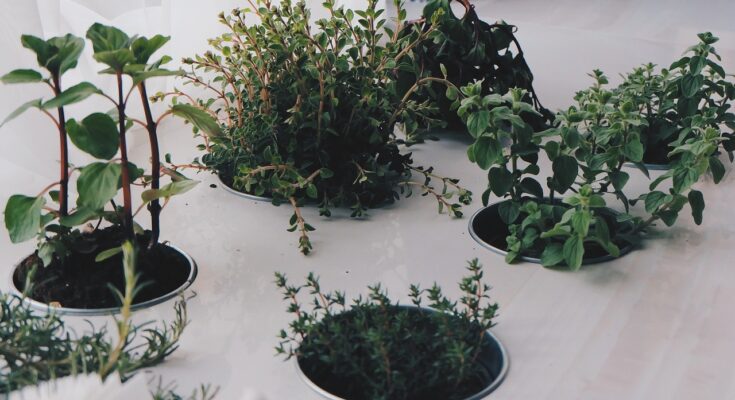Are you tired of constantly buying fresh herbs for your cooking? Why not create your own indoor herb garden? Not only is it a fun DIY project, but it also provides easy access to fresh herbs all year round. Plus, it adds a touch of greenery to your home decor.
The first step in creating your own indoor herb garden is choosing the right herbs. Consider which herbs you use most often in your cooking and which ones will thrive in an indoor environment.
Once you’ve chosen your herbs, it’s time to select the best containers and soil, position your garden for optimal light and temperature, and learn how to properly water, fertilize, and maintain your plants.
With a little bit of effort, you’ll soon be harvesting and using your homegrown herbs in your cooking, adding a delicious and fresh flavor to your meals.
Choosing the Right Herbs for Your Indoor Garden
Picking the perfect herbs for your indoor oasis is a crucial step in cultivating a thriving and aromatic sanctuary. Not all herbs thrive indoors, so it’s important to choose those that will do well in an indoor environment.
Some of the best herbs for indoor gardens include basil, mint, thyme, rosemary, and parsley. These herbs are easy to grow, require minimal maintenance, and add fresh flavors and aromas to your home.
In addition to the practical benefits of having fresh herbs at your fingertips, an indoor herb garden can also add to the aesthetic appeal of your home. There are many creative herb garden design ideas that can add a unique touch to your space.
Consider using hanging planters, wall-mounted shelves, or even repurposing old containers to create a one-of-a-kind herb garden. With a little creativity and the right herbs, you can create an indoor oasis that is both practical and beautiful.
Selecting the Best Containers and Soil

Now, let’s dig into finding the perfect pots and soil to help your little green friends thrive!
When selecting containers for your indoor herb garden, consider the materials that will best suit your needs. Clay pots are a popular choice because they allow for proper drainage and airflow, which is essential for healthy herb growth. Additionally, they are aesthetically pleasing and come in various sizes and colors. However, keep in mind that clay pots can be heavy and breakable, so handle them with care.
Another option for container materials is plastic. Plastic pots are lightweight, affordable, and easy to clean. They also come in various sizes and colors, making them a versatile choice. However, plastic pots do not allow for proper airflow, so be sure to poke holes in the bottom for drainage.
When it comes to soil mixtures, herbs prefer well-draining soil that is rich in organic matter. A good mixture consists of equal parts sand, peat moss, and perlite. This combination allows for proper drainage while retaining moisture and nutrients. Remember to avoid using garden soil, as it may contain weed seeds and pests that can harm your indoor garden.
With the right containers and soil, your indoor herb garden will thrive, and you’ll have fresh herbs at your fingertips all year round!
Positioning Your Garden for Optimal Light and Temperature
To make sure your herbs are happy and healthy, you’ll want to position them in the right spot for optimal light and temperature. This means creating a microclimate that mimics the conditions of their natural habitat.
If you are growing herbs that require full sun, they should be placed in a south-facing window or under grow lights for at least six hours a day. On the other hand, if you are growing herbs that prefer shade, like mint or parsley, they can be placed in a north-facing window or further away from the light source.
If you are unable to provide enough natural light, using artificial lighting can be a great solution. LED grow lights are an energy-efficient and cost-effective way to provide the right spectrum of light for your herbs. They come in a range of sizes and colors, so you can choose the best one to suit your space and the needs of your plants. Just be sure to position the lights close enough to the plants so they receive enough light, but not too close that they burn.
With the right positioning and lighting, your indoor herb garden can thrive year-round.
Watering, Fertilizing, and Maintaining Your Plants
Maintaining a healthy indoor herb garden is like tending to a delicate ecosystem; ensuring proper watering and fertilizing can help keep your plants thriving.
When it comes to DIY herb garden maintenance, it’s important to keep in mind that different plants may have varying watering needs. As a general rule of thumb, most herbs prefer well-draining soil that is moist to the touch but not waterlogged. To prevent overwatering, make sure your pots have drainage holes and avoid letting excess water accumulate in the saucer.
In addition to watering, your herbs will also need periodic fertilizing to ensure healthy growth. You can choose to use organic or synthetic fertilizers, depending on your preferences. For organic fertilizers, options include compost, worm castings, or fish emulsion. Synthetic fertilizers, on the other hand, typically come in granular or liquid form and can be applied according to package instructions.
Whatever type of fertilizer you choose, be sure not to overdo it as this can lead to burned roots and other issues.
By following these tips for healthy herb growth, you can enjoy fresh and flavorful herbs all year round!
Harvesting and Using Your Homegrown Herbs in Your Cooking
Get ready to add a burst of fresh flavor to your dishes with the bountiful harvest of your homegrown herbs, elevating your culinary creations to new heights. Whether you’re snipping some basil for your Caprese salad or adding some thyme to your roasted chicken, using fresh herbs in your cooking is a game-changer.
Not only do they add vibrant color and aroma to your dishes, but they also bring a depth of flavor that dried herbs just can’t match. To ensure that your herbs are always at their freshest, it’s important to know some herb preservation techniques.
One popular method is to freeze them in an ice cube tray with some water or oil. This way, you can easily pop a cube into your dish whenever you need a burst of flavor. Another option is to dry them by hanging them upside down in a cool, dry place. Once they’re completely dry, you can store them in an airtight container for future use.
By using these techniques, you’ll be able to enjoy the benefits of using fresh herbs in cooking long after your garden season has ended.
Frequently Asked Questions
What is the best way to prevent pests from invading my indoor herb garden?
To keep pests from invading your indoor herb garden, there are natural pest control techniques you can use. One effective method is companion planting. This involves planting certain herbs and flowers together that have natural repellent properties.
For example, planting marigolds alongside herbs like basil and oregano can help keep pests away. Another benefit of companion planting is that it can improve the overall health of your garden by promoting biodiversity and attracting beneficial insects.
So, if you want to keep pests at bay and create a thriving indoor herb garden, try incorporating companion planting into your gardening strategy.
Can I grow multiple herbs in the same container, or should they each have their own pot?
Growing multiple herbs in the same container is definitely possible, but it requires some careful planning and growing tips to ensure that each herb thrives. One container option is to use a long rectangular planter with dividers, which allows you to plant different herbs in separate sections.
Alternatively, you can choose a larger container and plant herbs with similar water and sunlight requirements together. Keep in mind that some herbs may grow faster and larger than others, so you may need to trim them back to prevent overcrowding.
Additionally, be sure to choose herbs that complement each other in terms of taste and growing habits. With the right container and growing tips, you can create a beautiful and functional herb garden right in your own home.
How often should I prune my herbs to promote growth and prevent overcrowding?
Pruning frequency is crucial to maintaining a healthy and prosperous indoor herb garden. It may seem daunting, but regular pruning will actually promote growth and prevent overcrowding. You don’t want your herbs to become too bushy, so trim them back regularly – once a week should suffice. But don’t overdo it; too much pruning can stress out your herbs.
Keep an eye on soil moisture as well, as overwatering can be just as harmful as underwatering. Remember, a little bit of TLC goes a long way when it comes to indoor herb gardening. And trust us, your herbs will thank you with an aromatic and flavorful bounty.
What are some common mistakes to avoid when starting an indoor herb garden?
When starting an indoor herb garden, it’s important to be aware of some common mistakes to avoid. Overwatering is a big one – herbs don’t like to sit in water, so make sure your pots have proper drainage.
Another mistake is not providing enough light – herbs need at least six hours of sunlight a day, so be sure to choose a sunny location or invest in grow lights. On the flip side, choosing the right soil is a key tip for success – herbs prefer well-draining soil with good organic matter.
By avoiding these common mistakes and following these tips, you’ll be well on your way to a thriving indoor herb garden.
Is it possible to grow herbs indoors year-round, or do they have a specific growing season?
Growing herbs indoors year-round is absolutely possible, and it’s a great way to ensure that you always have fresh herbs on hand for cooking and other uses. One of the keys to success is making sure that your herbs are getting enough light, as they would outdoors during the growing season.
This is where grow lights come in handy, providing the necessary light spectrum to promote healthy growth. The benefits of using grow lights include the ability to control the light and temperature conditions for your plants, which can help to optimize their growth and flavor.
With the right setup and care, you can enjoy fresh herbs from your indoor garden year-round.
Conclusion
Congratulations, you’ve just created your very own indoor herb garden! Now, all you need to do is sit back, relax, and watch your herbs grow.
Did you know that according to a recent study, 74% of American households now grow at least one herb or vegetable at home? That’s right, more and more people are realizing the benefits of growing their own produce, and you’re now one of them!
Not only does an indoor herb garden add a touch of greenery to your home, but it also allows you to have fresh, organic herbs at your fingertips any time you need them. Plus, it’s a fun and rewarding hobby that the whole family can enjoy.
So, whether you’re an experienced gardener or a newbie, with a little bit of patience and care, you can create a thriving indoor herb garden that will provide you with a constant supply of delicious and healthy herbs.
Happy gardening!




